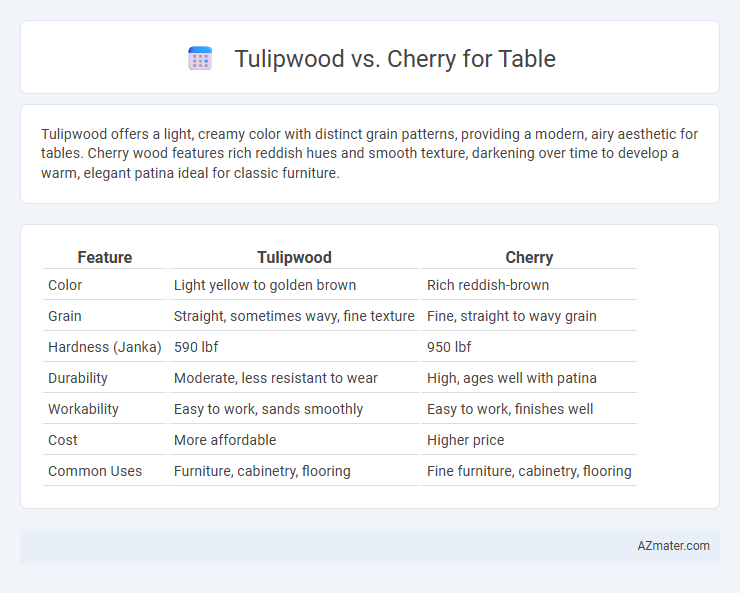Tulipwood offers a light, creamy color with distinct grain patterns, providing a modern, airy aesthetic for tables. Cherry wood features rich reddish hues and smooth texture, darkening over time to develop a warm, elegant patina ideal for classic furniture.
Table of Comparison
| Feature | Tulipwood | Cherry |
|---|---|---|
| Color | Light yellow to golden brown | Rich reddish-brown |
| Grain | Straight, sometimes wavy, fine texture | Fine, straight to wavy grain |
| Hardness (Janka) | 590 lbf | 950 lbf |
| Durability | Moderate, less resistant to wear | High, ages well with patina |
| Workability | Easy to work, sands smoothly | Easy to work, finishes well |
| Cost | More affordable | Higher price |
| Common Uses | Furniture, cabinetry, flooring | Fine furniture, cabinetry, flooring |
Introduction to Tulipwood and Cherry
Tulipwood, known for its light yellow to pale reddish-brown hue, offers a smooth texture and moderate hardness, making it a durable choice for tables with a contemporary aesthetic. Cherry wood features a rich reddish-brown color that deepens with age, prized for its fine grain and workability which adds warmth and elegance to furniture pieces. Both hardwoods provide excellent stability and longevity, but their distinct color palettes and grain patterns influence the overall design and ambiance of the table.
Key Characteristics of Tulipwood
Tulipwood is a hardwood known for its light color with subtle yellow and pinkish hues, offering a smooth, fine grain pattern that exudes a clean, modern aesthetic ideal for tabletops. Its durability and moderate hardness make it resistant to everyday wear and dents, while the wood's natural oils provide inherent moisture resistance, enhancing its suitability for dining surfaces. Compared to cherry, tulipwood maintains a more consistent color over time without darkening significantly, preserving a fresh look with minimal maintenance.
Key Characteristics of Cherry Wood
Cherry wood features a rich reddish-brown color that deepens with age, offering a warm and elegant appearance ideal for furniture like tables. It is prized for its fine, straight grain and smooth texture, which provide a refined finish and excellent workability. Compared to tulipwood, cherry wood's durability and resistance to abrasion make it a preferred choice for high-quality, long-lasting tabletops.
Color and Visual Appeal Comparison
Tulipwood showcases a vibrant, warm golden-yellow hue with striking pink to reddish streaks, creating a visually dynamic grain pattern that adds a bold, exotic charm to tables. In contrast, cherry wood offers a rich, reddish-brown color that deepens over time into a smooth, lustrous patina, contributing to a classic and elegant aesthetic. The distinct color evolution of cherry wood contrasts with tulipwood's consistently bright and varied appearance, making each ideal for different styles of table design.
Durability and Strength Differences
Tulipwood offers moderate durability with a Janka hardness rating around 950, making it suitable for light to medium use tables, while Cherry wood boasts a higher hardness of approximately 995, providing enhanced strength and resistance to dents and scratches. Cherry's tight grain structure contributes to its superior durability, making it a preferred choice for long-lasting, sturdy furniture. Tulipwood's slightly softer nature means it may show wear more quickly, though its affordability and ease of working make it an acceptable option for less demanding table applications.
Workability and Ease of Craftsmanship
Tulipwood offers excellent workability due to its relatively soft texture and uniform grain, allowing for smooth cutting and shaping without excessive wear on tools. Cherry wood, prized for its fine, straight grain and moderate hardness, provides a balance of durability and ease of craftsmanship, making it ideal for detailed joinery and finishing. Both woods are favored by artisans, but tulipwood's softness makes it more forgiving for novice woodworkers, whereas cherry's density enhances the final product's strength and polish.
Cost and Availability Considerations
Tulipwood is generally more affordable than cherry, making it a cost-effective option for tables without compromising on quality. Cherry wood, prized for its rich color and fine grain, tends to be more expensive and less readily available due to slower growth rates and higher demand. Availability of tulipwood is widespread in North America, while cherry may require sourcing from specialized suppliers, affecting both price and lead times.
Environmental Impact and Sustainability
Tulipwood is a fast-growing hardwood primarily sourced from sustainably managed plantations, making it a more environmentally friendly option compared to cherry wood, which often comes from slower-growing, older trees. Cherry wood, while prized for its rich color and durability, typically has a higher environmental impact due to slower replenishment rates and more intensive logging practices. Choosing tulipwood for tables supports sustainable forestry by reducing deforestation pressure and promoting renewable resource use.
Best Uses for Tulipwood vs Cherry in Table Design
Tulipwood offers a striking grain pattern and vibrant color, making it ideal for decorative table designs and accent pieces where visual impact is prioritized. Cherry wood features a smooth texture and rich, warm tones that deepen over time, best suited for classic dining tables and furniture requiring durability and a refined finish. Both woods provide excellent workability, but tulipwood excels in contemporary styles, while cherry remains a preferred choice for traditional and heirloom-quality tables.
Final Selection: Which Wood is Right for Your Table?
Tulipwood offers a lighter, more affordable option with distinct grain patterns and moderate durability, ideal for casual or modern table designs. Cherry wood, known for its rich reddish-brown hue and excellent hardness, provides long-lasting strength and an elegant, timeless appearance that deepens with age. Choosing between Tulipwood and Cherry depends on your budget, desired aesthetics, and how much wear your table will endure over time.

Infographic: Tulipwood vs Cherry for Table
 azmater.com
azmater.com